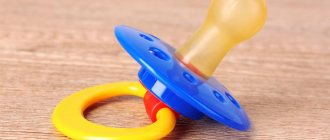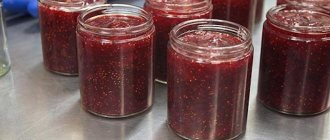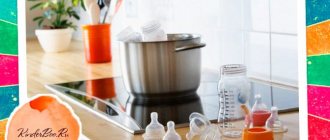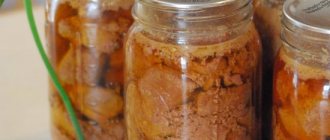Kosmoteros Professionnel Sunscreen cream SPF 30, 50 ml
952 ₽ More details
Kosmoteros Professionnel Sunscreen cream SPF 50, 50 ml
1683 ₽ More details
Kosmoteros Professionnel
It is necessary to sterilize your breast pump. Leftover breast milk is a fertile ground for the development of bacteria, which can subsequently cause inflammation of the mother’s breasts and indigestion in the child. Sterilizing a breast pump is a simple procedure that helps keep mother and baby healthy. There is a large selection of devices for antimicrobial treatment of these devices, but you can get by with a regular pan of water.
What is it for?
Before considering the question of how to sterilize a breast pump at home, you should understand what kind of device it is and what it is needed for.
A breast pump is a simple device that allows you to express milk from a woman’s breast into a special container. Currently, you can find two versions of this technology: with a manual and automatic basis. There are several reasons to buy a breast pump:
- It helps increase the amount of milk in the breast.
- Using it, you can strain maternal fluid into a special container and feed it to your baby through a bottle.
- You can express excess milk, easing the heaviness of your breasts.
Thanks to this device, you can save a young mother from many serious diseases, such as mastitis, the appearance of a tumor, premature sagging of tissues and much more. Do I need to sterilize my breast pump? Of course! This device should always be environmentally friendly!
Rating of the best breast pumps
Many young mothers prefer milk pumps from the manufacturer Philips AVENT. There are four types of devices in the range. They do not break after use, so you have a chance to buy a used breast pump from this manufacturer in good condition. A slightly less popular, but very common and sought-after brand is Medela. This is a brand from Switzerland. They offer electric breast milk pumps to postpartum women. The products are high quality.
Devices from companies such as Chicco, Canpol and Nuk are less in demand. But they are also high quality. Some mothers note that the devices from these companies are not as convenient as Philips AVENT or Medela. There are also domestic ones, “The World of Childhood”). They are affordable. But you won’t find electric milk pumps with them. The quality of the devices is characterized by reviews as average.
- the most gentle manual: Medela Harmony
- the most successful (manual type): AVENT Philips manual 330/20
- popular mobile manual breast pump: Tommee Tippee Сloser to Nature
- high-quality piston “World of Childhood” with milk container
- high-quality pump: breast pump with bottle Chicco pump
- the most productive electric home: Medela Freestyle electronic (expensive)
- the most convenient and popular electronic: Philips AVENT SCF332/01
- the most powerful budget electronic: Medela Swing Maxi
Why does it need to be sterilized?
There are several reasons why it is imperative to sterilize your breast pump:
- Mother's milk, like any other, can turn sour. This will happen especially quickly if it is stored incorrectly. As a result, an unpleasant odor is formed, which will be quite difficult to get rid of in the future.
- If this procedure is not done in a timely manner, bacteria will begin to multiply. In the future, they will penetrate the child’s body, which will lead to the formation of colic, heartburn and even diarrhea.
- Even a thoroughly washed device can accumulate old milk residues. This can significantly spoil the taste of the liquid you have just expressed. Don’t be surprised if your baby starts actively spitting it out.
A young mother may not be at all interested in the question of how to sterilize a breast pump, only if she uses it only to relieve the feeling of heaviness in the breast, and she herself does not use its components to feed the child.
Sterility when expressing
Usually they pump in three cases: – you want to leave the house and leave lunch for the child,
– you have cracked nipples and it hurts when your baby suckles,
– you have a lot of milk and you want to express it and save it (freeze) for some unforeseen event (you have business trips or suddenly you get sick and will be treated with antibiotics).
In all these cases (as well as in all other cases when you plan to either freeze and save the expressed milk, or give it to the baby a little later), you need to carefully sterilize everything connected with it.
Namely:
– breast pump,
– a bottle into which milk is collected from the breast pump,
- container in which milk will be stored.
Those who regularly freeze milk usually use special disposable sterile milk bags. They are sold in pharmacies. Their advantages are that they do not need to be sterilized (they are already sterile), they take up little space in the refrigerator when frozen, and they can be connected directly to the breast pump without using a bottle. If you will be feeding your baby with expressed milk in a couple of hours, store it in the bottle you use to express it. If you don’t have sterile bags on hand and need to freeze milk, use small glass jars. Baby food jars are very convenient. You need to tear off the papers from them and wash off the remaining glue (if the glue cannot be washed off with ordinary means, spread this place on the jar with simple vegetable oil (olein, golden seeds, etc.), let it stand for 3 minutes and after that the glue will be easily removed).
So, your steps for sterilization: 1. Disassemble the breast pump into screws and thoroughly wash all parts with detergent or baby soap. 2. Wash a glass jar with a lid, a bottle with a nipple and a lid with detergent. 3. Rinse all parts of the breast pump, bottle with nipple and lid, or glass jar with plenty of water. 4. If you will sterilize in a sterilizer, load it into the sterilizer and follow the instructions. If there is no sterilizer, load everything washed into a pan, fill with water so that all parts are immersed in water, bring to a boil and boil for 15 minutes. 5. After boiling, drain the water from the pan, holding the contents with a lid, let it cool for a couple of minutes so as not to burn yourself, and you're done!
You have a sterile kit for expressing and storing milk. It remains sterile for about 30 minutes.
How to Express Breast Milk
Why is it necessary to sterilize a breast pump?
Leftover old milk is an ideal environment for bacteria to multiply. A poorly washed breast pump, bottle and jar can cause the milk to turn sour. It's even worse if this leads to bacteria entering the child's body. There can be many “surprises” here - from stomatitis to intestinal infections in a child.
So sterilize everything thoroughly.
(12)(1)
Share on WhatsApp
Similar articles:
- How to express milk?
- How to boil baby bottles
When should you do this?
Another important question is when to do this procedure. Ideally, this should be done after each pumping session. That is, fresh milk needs to be poured into a small bottle, and all components of mother’s assistant must be carefully processed. How often to sterilize a breast pump for young parents depends only on how many times a day the pumping process will be carried out.
If the mother does not use this milk to feed the baby, then it is enough to treat the device once a day.
Preparatory work
Before moving on to the process of sterilizing a breast pump, you will need to do several preparatory procedures:
- You should carefully disassemble the device into several components. As a rule, this is a handle through which pumping is carried out, a container for storing liquid, a valve and various connecting components.
- Next, you should prepare a deep container or special bags. If a dish is used for sterilization, it must be made of glass or metal. It is strictly not recommended to use plastic products, as they can harbor bacteria. You may also need a small saucepan.
- It is worth preparing in advance the material on which the treated breast pump will be stored. It must also be clean. For example, you can use a boiled baby diaper, towel or gauze.
Once everything is ready, you can begin the main work.
The easiest way
Many young mothers are concerned about the question of how to sterilize a breast pump at home without spending a lot of time. It's very easy to do. To do this, you need to purchase special sterilization packages at the pharmacy, the cost of which is about one hundred rubles. The processing process consists of several stages:
- Each part of the breast pump should be washed under running water. You can use baby dishwashing detergent.
- Next, you need to attach a package to the component of each part. It should adhere well to the walls of the device.
- After which the parts must be placed in the freezer.
- After 30 minutes, you should take out the parts of the breast pump, free them from the bags and carefully remove the remaining paper.
- If necessary, you can lubricate the device with a small amount of vegetable oil and leave to dry for a few minutes.
You can treat other baby utensils in the same way, including nipples and bottles.
Sterilization by boiling
Can a breast pump be sterilized at high temperatures? Naturally, yes, but this method is only suitable for devices made of durable material. Everyone’s favorite grandmother’s method consists of just a few steps:
- First of all, as in the previous case, you need to disassemble the mechanism and wash it under running water.
- Next, you need to pour a small amount of water into the pan and put it on high heat.
- As soon as the liquid boils, you can place the components of the breast pump into the container.
- After 15 minutes the device can be removed. It is recommended to use two forks for this.
- Now all that remains is to place it on a clean cloth and wait until it dries completely.
You can boil all the ingredients in one container. However, the effect will be better if it is possible to treat each part in renewed water.
Breast pump treatment methods
The instructions for use describe how to clean your breast pump. For example, a mechanical gadget from Avent can be washed in the dishwasher, boiled, or processed in the microwave.
If a mother expresses frequently in order to leave food for the baby or to form a breast milk bank, then the device will have to be sterilized regularly. It is more convenient to purchase a special device for this – a sterilizer.
Boiling
You can sterilize the parts of the device using the old-fashioned method. Previously, women used boiling water to kill bacteria. Modern mothers are helped with this by a microwave and professional sterilizers. However, some women continue to seethe.
To kill bacteria, place the parts in a pan of cold water and bring to a boil. After boiling, it is recommended to wait 5 minutes, then remove the breast pump elements. Sometimes mothers wait 15 minutes, but with prolonged boiling the plastic may become cloudy.
In the microwave
It is more convenient to sterilize baby dishes and breast pump parts in the microwave. Elements made of plastic and silicone are cleaned using steam, similar to boiling. Oven processing is faster and the procedure itself is less troublesome.
To sterilize in the microwave, you need to have special bags or containers. 200 ml of water is poured inside the bag and a breast pump is placed. The package must be placed in the microwave and turned on the standard mode for one and a half minutes. Processing will end after a beep.
You can buy bags for sterilization in the microwave in stores selling children's goods. One package is enough for 20-30 treatments.
For a couple
You can sterilize a device for expressing milk using steam. The point of cleaning is to heat up the gadget parts as much as possible. At high temperatures, bacteria that accumulate on the walls of the device die.
The steam structure is made from a saucepan and a regular colander. Pour water into a container and bring to a boil. The parts of the pumping gadget are separated and placed in a colander. After this, the mesh kitchen aid is placed over boiling water. Women who use this method note that after steam treatment there are no traces of limescale left behind, as during boiling.
The sterilized device remains transparent and does not lose its presentation.
Using a multicooker, you can also clean breast pump parts from bacteria. You need to pour water into a large bowl and select the steam cooking mode. A grill for the multicooker is installed on top, which is included with the system. After 10-15 minutes, cleansing will be completed.
Steam sterilization
How to sterilize a manual breast pump? Many young mothers buy this device in order to save money. It is worth noting that manufacturers also skimp on the material for its creation. After just a few treatment procedures in boiled water, you can notice that an unwanted coating has appeared. To prevent this from happening, it is recommended to sterilize such a device using steam:
- Pour a small amount of water into the pan. It is enough that it slightly hides the bottom.
- Next, you need to cover the container with a lid and wait for the boiling process.
- Once this has happened, place a colander on top of the pan and place each part of the breast pump into it.
The entire sterilization process in this way can last up to 30 minutes. After which all the parts also need to be laid out on cloth and waited until they dry completely.
Sterilization methods
There are several ways to sterilize breast pumps at home:
- boiling;
- in the microwave;
- ferry;
- cold method (UV rays, soluble tablets).
All methods are equally effective if used correctly. You must first read the product care instructions.
Boiling
You can boil the breast pump in a regular saucepan. Procedure:
- Place all parts to be sterilized into a pan;
- pour water so that it covers the entire contents;
- bring to a boil, keep on medium heat for 15 minutes (many experts say that 5 minutes is enough).
If you use tap water, you need to fill it with cold water. Hot water often contains impurities that will subsequently settle on the parts.
In the microwave
Sterilizing a breast pump in the microwave is a much less troublesome procedure than boiling it. The destruction of microbes occurs under the influence of hot steam.
For sterilization it is convenient to use special bags, for example from Munchkin. Each is designed for 30 procedures (there are windows for marks). You need to pour about 200 ml of water into the bag and place the breast pump in it. The processing process lasts 90 seconds. Medela packages can withstand 20 procedures. In addition to the breast pump, they can accommodate 4 bottles and a pacifier.
There are special sterilizers for microwave ovens. Their design is simple - it is a plastic container with a double bottom and a lid. You need to pour some water down, put a grill, place the breast pump parts on it and close it.
For a couple
You can also treat your breast pump with hot steam on the stove. Procedure:
- fill the pan 1/3 full with water and place it on the stove;
- place a metal colander on top and place the breast pump parts in it;
- bring to a boil, cover with a lid, and keep the colander over the steam for 25 minutes.
After processing, place the parts on a clean napkin to cool. When sterilized by steam, there is no limescale left on the parts, as when boiling.
Electric sterilizers provide high-quality steam treatment of the breast pump. The design is the same as in microwave ovens. Steam is generated by heating the bottom.
For steam disinfection, you can use a multicooker. The bowl and container for steam dishes must first be rinsed well, then pour at least a liter of water, place the steam bowl on top and place the breast pump in it. To process, turn on the “sterilization” or “steaming” mode. The process will take on average 15–20 minutes. You can also use a regular steamer with the same success.
Breast pumps often develop a persistent yellow tint when used frequently. To get rid of it, you need to put the part in a pan of water, add a teaspoon of citric acid and boil for 5 minutes. Then the parts are removed and washed with cold running water.
“Cold” sterilizers
Cold sterilization is performed using special tablets. An example of a device is the Tommee Tippee Closer to Nature, manufactured in Great Britain. Essentially, this is an ordinary container into which you need to pour water and dissolve the tablet. The breast pump is immersed in the solution for half an hour. Once removed, it is sterile and safe.
There are also ultraviolet sterilizers. They are portable and reliable. Operates on batteries or mains. Their only disadvantage is their high cost and difficulty in purchasing (they are rarely available in stores). The sterilization process takes from 5 to 15 minutes. Examples of devices: ErgoPower UV05, Innoliving INN-302, Ecomom ECO-70KA.
Some women believe that it is enough to rinse the breast pump with boiling water, but experts insist on complete sterilization. The measure is especially relevant for mothers with newborns, whose immunity has not yet developed. Sterilization will also prevent nipple infections and inflammation.
Boiling water sterilization
How to sterilize a breast pump if there is absolutely no time or additional containers? For example, if this needs to be done in a hospital or maternity hospital. To do this you will need a deep glass plate and water:
- First of all, you need to disassemble the breast pump and rinse each of its components under running water.
- Now place all the parts in a plate and pour boiling water over them. The container must be closed with a tight lid.
- After 30 minutes, drain the water and pour in cold, lightly salted water.
- You should leave the device rinsed in this way for no more than five minutes.
- All parts should be removed from the plate and wiped with a clean rag.
This method is one of the simplest, but cannot guarantee a high degree of effectiveness.
Sterilization of different types of breast pumps
The breast pump sterilization procedure should be carried out after each use, treating all parts of the device. Even those accessories that seem clean.
How to sterilize a manual breast pump
All parts of the manual breast pump can be processed. There are no elements in it that should not be exposed to moisture. First, disassemble the breast pump and thoroughly clean the surfaces of its components. Wash the bottle, nipple, cap and handle under hot water and a mild detergent. After this, you can begin the sterilization procedure.
How to sterilize an electric breast pump
Since this device is electric, you should read the manual in advance to determine which parts can be washed and sterilized and which cannot. This will help you maintain your pumping device and ensure it has a long lifespan. You can use the boiling procedure or choose one of the methods described below. You just need to load all the parts to be sterilized into the processing tank and follow the instructions.
A few words about the Avent breast pump
When talking about breast pumps, we cannot ignore the legendary devices. It is this product that has gained enormous popularity among mothers of all countries over the past five years. There are several reasons why you need to pay attention to this particular model:
- First of all, this is quality. Users claim that the breast pump from this company will last for many years. Each fastening is made as carefully as possible; the device will not wear out, even if it has to be disassembled and reassembled more than 10 times a day.
- Durable and environmentally friendly material that is absolutely safe for the baby.
- Large assortment of goods. If there is a need to choose an Avent breast pump, then you will have the opportunity to purchase the most convenient option from a great variety. There are several types of manual and automated devices.
Currently, there are a huge number of breast pumps from different companies. These products have received a huge number of positive reviews from young mothers. Undoubtedly, this inspires great confidence.
How to sterilize an Avent manual breast pump?
It has already become clear which brand of device you need to choose for expressing milk. Now it’s worth saying a few words about how to sterilize an Avent breast pump. It consists of two main parts - a small bulb for storing liquid and a comfortable handle. To a greater extent, it is necessary for breast development rather than for full feeding of the child.
It is recommended to process such a device in two ways. The best way to do this is by “steaming” with boiling water. It is the most effective and reliable. If possible, it is recommended to do this using a special device - a sterilizer, which can be bought at a medical supply store.
How to choose?
For example, it is important to decide whether the mother will only pump occasionally or whether she is going to go to work or school soon, and it is important for her to collect and store some of the milk frozen. After all, breastfeeding is irreplaceable for the baby, his immunity and laying a healthy “foundation” for the entire small body, literally every day is important! Therefore, a “home” breast milk bank will be a good help for a mother who will leave her baby with dad, grandmother or nanny for some time.
It is easier to create “strategic reserves” using an electronic device. But if pumping is irregular, it is more advisable to prefer a manual device.
Your choice of device is also influenced by your opinion about the time you are willing to spend pumping. A manual model is definitely not a solution if you are planning on long-term breastfeeding and plan to sit with your baby for almost the entire maternity leave. But an electronic device that will help you express your portion faster and more efficiently is a completely different story.
Of the modern models on the market today, mothers very often recommend Philips AVENT breast pumps on forums and in personal communication. “Comfortable”, “convenient”, “doesn’t make noise”, “comfortable for the breast”, “expresses without discomfort”, “expresses to the last drop” - this is how mothers characterize their experience of using AVENT products. Especially a lot of reviews about increasing the mother’s comfort when pumping appeared after the release of the Natural series of devices. And there is nothing unusual about this, because these are innovative models that no longer require the mother to bend over when pumping, but provide the opportunity to relax.
Stress is the first enemy of breastfeeding (hence the opinion of doctors that “mom feeds not with the breast, but with the head”), and therefore the ability to disconnect from the stimuli of the outside world and fully concentrate on the process has a beneficial effect on lactation.
A mother, determined to breastfeed her baby for a long time, acts very wisely. But when choosing an assistant for this difficult period, she is faced with a choice: which option is better to prefer, manual or electronic?
First you need to understand the design features of each variety. Both options have their advantages. For example, a hand-held device is a fairly simple device. It is based on a piston, which is activated by a special handle. When you press it, the air is removed between the chest and the cone, resulting in a vacuum being created, under the influence of which the liquid comes out of the chest.
The electronic model has the same principle. The only difference is that the piston is driven automatically by an electric motor. This makes it possible to express to the last drop using an electric device, which is very important in the development of lactostasis.
How to sterilize a breast pump with a bottle?
It is also worth saying a few words about the most popular breast pump with a bottle. It consists of three main components - a reliable handle, a funnel and a bottle of various sizes: 100, 150 or 200 ml. By pressing the handle, milk is expressed into a special container. Then you can drain it or feed it to your baby.
How to sterilize an Avent breast pump with a bottle? This can be done in absolutely any way. Durable material can withstand the highest temperatures, so it is recommended to choose the boiling or steam treatment method. In order to prevent the appearance of unwanted scale, after sterilization, you should rinse the device with cold boiled water and wipe thoroughly with a clean rag.
Breastfeeding is a very important process for every mother. Through natural feeding, you can strengthen your baby’s immunity, avoid colic and save money on buying formula. It's great that there are special devices that can help simplify this process. It is very important to know how to sterilize your breast pump. This will avoid adverse consequences. To do this, it is not necessary to use special equipment or contact qualified centers. This procedure is quite simple to do at home using improvised means. The entire processing process will take no more than ten minutes.
Some ideas for sterilizing your breast pump
Steam treatment
This procedure can be carried out at home, but in the maternity hospital, unfortunately, the necessary equipment is unlikely to be found. The best option is to use a double boiler, but, unfortunately, not every housewife can boast of having one. Then a saucepan, a colander and a lid will help. You need to fill the pan with water and bring it to a boil, then place a colander on top. The breast pump is placed in a colander, namely its disassembled parts, which have been previously washed, and covered with a lid. In this method, the sterilization process is carried out for at least 10 minutes.
Boiling water treatment
This method is quite easy to implement, even while in the maternity hospital. It is enough to ask the staff or directly in the kitchen for the required amount of boiling water and carry out the mandatory sterilization procedure. To do this, you need to place the previously disassembled and washed breast pump in a container with water that has reached boiling temperature and leave all its components in boiling water for 10 minutes. If the mother is no longer in the maternity hospital and has access to the kitchen, then she can use a slightly modified method of using boiling water to sterilize the pumping device. To do this, place the disassembled device in a container of water. The container should be large and the water in it should cover all parts of the breast pump. All this must be brought to a boil over the fire and boiled for 5 minutes. After which the device can be used without fear of harming the child.
Unlike mothers in the maternity hospital, nursing women who have left its walls can choose the method of sterilizing the device that they prefer. Most women who had the opportunity to compare first-hand the benefits of both methods of sterilizing a breast pump using improvised means noted that they liked the use of steam more.
They justified this choice by the fact that when processing the device for expressing breast milk, there is no plaque on it that forms on the surface after boiling. It is difficult to argue on this issue, because everyone chooses what they consider necessary and has every right to do so. After all, both methods disinfect the device and provide it with proper sterility, which means they have a place.
In addition to the fact that the device for expressing breast milk must be sterilized before use, due attention should also be paid to its preliminary cleaning. After all, before placing it in a sterilizer, in a steam bath or in boiling water, the device must be cleaned of contamination, in the form of milk residues.











